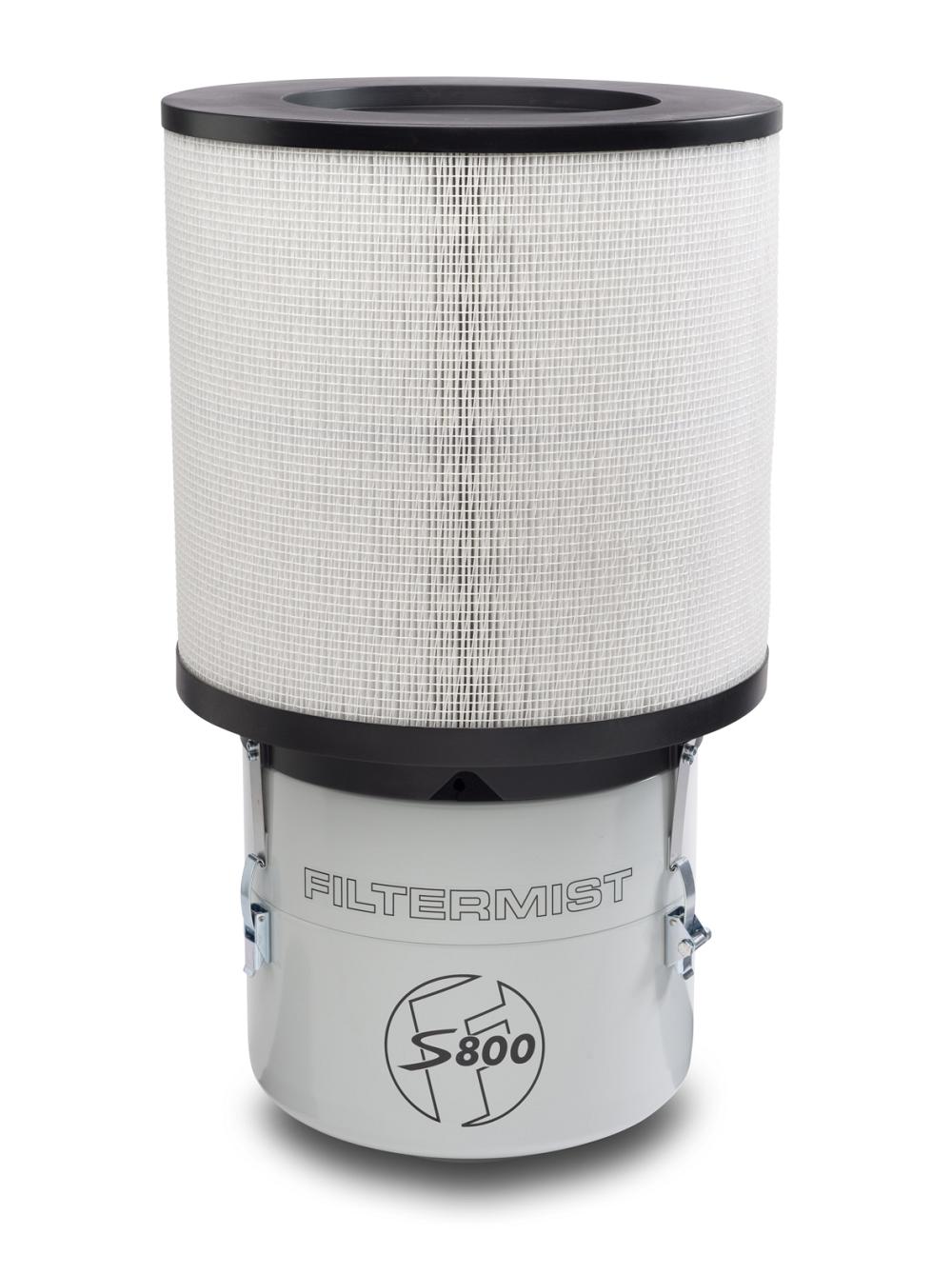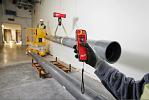- FMA
- The Fabricator
- FABTECH
- Canadian Metalworking
Protect Workers By Minimizing Exposure To Oil Mist
Many oil-removal machines area available, so choose the one that fits your application
- By Lydia Barber
- August 30, 2016
- Article
- Metalworking

Oil mist should be captured at the machine to eliminate the threat to worker safety. Photo courtesy of Filtermist.
Despite the increasing use of metalworking fluids since the early 1800s when the first lathe was invented, it has been only in the last 30 years or so that the dangers of exposing workers to hazardous airborne substances have become widely recognized, with legislation and guidance designed to protect workers put in place.
Exposure to airborne oil mist particles can cause a number of occupational diseases, including skin conditions, respiratory problems, and even cancer.
“In an ideal world we would like to see effective oil mist filters fitted as standard to all machine tools. However, we realize that this is not always possible for a variety of reasons, so we want to raise awareness amongst the world’s global manufacturing community of the importance of investing in oil mist removal equipment that works,” said Filtermist Managing Director James Stansfield.
What Is Oil Mist?
Oil mist is created when machine tools spray metalworking fluid to help lubricate the tool or keep metal components cool. Industrial lubricants are used in a variety of manufacturing processes, including grinding, milling, drilling, turning, and finishing.
Manufacturers initially used water to cool the surface of the metal and then moved on to other types of lubrication, including lard, as speeds increased. Today’s modern machine shops use a variety of fluids depending on the purpose of the application.
Four basic types of metalworking fluids are used to keep metal cool during manufacturing processes:
- Straight oils (also known as cutting or neat oils)
- Soluble oils
- Semisynthetic fluids
- Synthetic fluids
Each has its own specific properties and is more suitable in certain applications, but they all have one thing in common: They all generate airborne mist particles when sprayed.
Particle Size
Oil mist particles that are larger than 3.5 microns are separated in the nose and throat, while particles smaller than 1 micron are absorbed into the bloodstream. Particles between these sizes are retained by the throat, bronchial tubes, and lungs, causing a variety of occupational diseases. To put this into perspective, the diameter of an average human hair is between 10 and 50 microns.
Canada has a number of regulations designed to protect workers from the dangers of exposure to oil mist particles. Part X of the Canada Occupational Health and Safety Regulations includes a section on control of hazards, which outlines recommendations on protecting employees from hazardous substances.
The World Health Organization’s “Occupational Health,” a manual for primary health care workers, includes details on the primary prevention of occupational diseases such as those caused by exposure to airborne oil mist.
The manual states that primary prevention is accomplished by reducing risk. In the occupational setting, this is most commonly done by reducing the magnitude of exposure to hazardous substances. As the dose is reduced, so is the risk of adverse health consequences. This is best accomplished by changing the production process and associated infrastructure, such as ventilation equipment.
In addition to the hazards oil mist poses to human health, oil mist also is a fire risk and can cause slips and falls if droplets are allowed to build up on surfaces where workers walk. Accumulation on sensitive electronic apparatus can cause equipment to fail, interrupting production and resulting in costly downtime.
“The need for effective oil mist extraction is now widely recognized, and this is reflected in the growing demand for oil mist collectors,” said Mark Kirkman, managing director of AMT Machine Tools, a Filtermist distributor based in Rexdale, Ont. “Unit sales increased by 50 per cent in Canada between 2012 and 2015, and that trend looks set to continue.”
Oil Mist Removal
Oil mist and other harmful airborne hazards can be removed using dilution or “general” ventilation designed to remove polluted air before levels of contamination become unacceptably high. They also can be removed by local exhaust ventilation (LEV), which captures, contains, and treats contaminated air at the source before it has an opportunity to escape into the wider working environment.
Manufacturers can choose from stand-alone systems that consist of one or more oil mist filters located on or next to each individual machine tool, or they can opt for centralized extraction systems.
Both have their merits, depending on the nature of the business.
For example, some aerospace manufacturers prefer stand-alone systems because this approach gives them the to reconfigure their workshops for different projects if required. Alternatively, automotive manufacturers often choose centralized extraction systems as their production lines are fairly static.
As with any other machinery, LEV systems should be regularly checked by a competent person to ensure they are performing as intended.
Currently three methods are used to collect and remove oil mist generated by machine tools:
- Static filter media
- Electrostatic
- Rotating filter units that use centrifugal force
Static Filter Media. Units with static filter media generally are used for high-volume applications and in centralized extraction systems. As air is drawn into the unit, heavier particles fall to the bottom and are pumped out for collection or reuse. Polluted air then travels up through the first filter cassette, which traps smaller particles; if necessary, an additional filtration process can be included in particularly demanding applications.
Electrostatic Filters. Electrostatic filters use an ionizer that produces an electrostatic charge that collects and traps air pollutants on an internal baffle plate. This type of filter is effective for welding fume and smoke applications, but not as good for oil mist because the mist can build up on the plates quite quickly. This reduces the amount of airborne contaminants that are effectively captured, so the units need regular cleaning to ensure they are operating efficiently.
Centrifugal Force Systems. In a centrifugal system a perforated drum with specially designed vanes rotates at high speed. Oil mist is drawn into the unit and impacts on the vanes at high velocity. Special drum pads assist the coalescing process and filter out stray particles. Centrifugal force pushes oil to the unit’s outer case where it drains back to the machine for reuse or collection and clean air is returned to the workshop through the top of the unit.
“All employers have a responsibility to protect their workforce from hazards that can lead to occupational diseases,” said Stansfield. “The introduction of targeted guidelines and legislation around the world appears to be having a positive effect on workers’ health. We hope that one day all machine shops will be free from oil mist contamination. The means are there, but the global manufacturing industry as a whole needs to make sure that employers are educated about the dangers of oil mist and the relative ease with which the problem can be resolved.”
Lydia Barber is marketing and communications manager, Filtermist, 44-1952-290500, www.filtermist.com.
AMT Machine Tools, 416-675-7760, www.amtmachine.com
About the Author
subscribe now


Keep up to date with the latest news, events, and technology for all things metal from our pair of monthly magazines written specifically for Canadian manufacturers!
Start Your Free Subscription- Industry Events
ZEISS Quality Innovation Days 2024
- April 15 - 19, 2024
Tube 2024
- April 15 - 19, 2024
- Düsseldorf, Germany
CTMA Economic Uncertainty: Helping You Navigate Windsor Seminar
- April 30, 2024
- Windsor, ON Canada
MME Winnipeg
- April 30, 2024
- Winnipeg, ON Canada
CTMA Economic Uncertainty: Helping You Navigate Kitchener Seminar
- May 2, 2024
- Kitchener, ON Canada




















